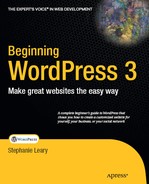Book Description
WordPress is one of the most popular blogging and content management web templating platforms—it easily allows you and your business to make a statement about yourself and what you do. WordPress is also quite cost-effective, as it's free for just about anyone to use.
WordPress is colorful and flexible, and includes a variety of themes, templates, and plug-ins for you to explore and use. Beginning WordPress 3 aims to address these for the beginner who wants to start using and developing with WordPress.
This book is one of the first on the latest WordPress 3.0 engine.
With this book, you'll learn about blogging, developing a blog, creating newsletters/papers, and managing/publishing this popular CMS.
The author, Stephanie Leary, brings you her expertise as a professional trainer and educator who has used WordPress extensively in education and more.
Table of Contents
- Copyright
- About the Author
- About the Technical Reviewer
- Acknowledgments
- Introduction
- 1. About WordPress
- 2. Installing and Upgrading
- 3. Dashboard and Settings
- 4. Working with Content
- 4.1. Posts
- 4.2. Pages
- 4.3. Posts vs. Pages: Same, but Different
- 4.4. Media Files
- 4.5. Links
- 4.6. Feeds
- 4.7. Summary
- 5. Importing Content
- 6. Creating a Basic Theme
- 6.1. Using Widgets
- 6.2. Using Menus
- 6.3. Using Header and Background Images
- 6.4. Turning HTML into a Theme
- 6.5. Template Tags
- 6.6. Theme Files
- 6.7. Theme File Hierarchy
- 6.8. Listing Comments
- 6.9. Including Additional Files
- 6.10. Styling Content
- 6.11. Changing Appearance Based on Context
- 6.12. Creating Navigation Menus
- 6.13. Theme Functions
- 6.14. Child Themes
- 6.15. Troubleshooting Themes
- 6.16. Summary
- 7. Creating an Advanced Theme
- 7.1. Modifying the Loop
- 7.2. Multiple Loops
- 7.3. Accessing Post Information Outside the Loop
- 7.4. Search Engine Optimization (SEO)
- 7.5. Adding Scripts and Stylesheets
- 7.6. Outside the Theme Hierarchy: Database Errors and Maintenance Messages
- 7.7. Theme Options
- 7.8. Theme Frameworks
- 7.9. Distributing Themes
- 7.10. Summary
- 8. Creating Widgets
- 9. Creating Plugins
- 9.1. Getting started
- 9.2. Creating a Template Tag
- 9.3. Adding an Options Page
- 9.4. The Settings API
- 9.5. Wrapping Up
- 9.6. Plugin Possibilities
- 9.7. Hooks: Filters and Actions
- 9.8. Variations on Option Pages
- 9.9. Publishing a Plugin
- 9.10. Summary
- 10. Users and Roles
- 11. Performance and Security
- 12. Custom Content Types, Taxonomies, and Fields
- 12.1. Custom Taxonomies
- 12.2. Custom Content Types
- 12.3. Custom Fields in Custom Content Types
- 12.4. Summary
- 13. Setting up the Network
- A. Plugin Index
- B. Theme Functions
- C. Plugin Recipes
